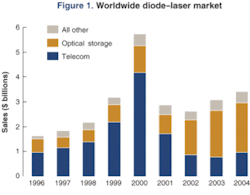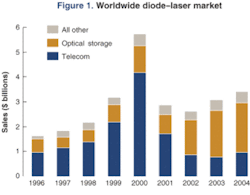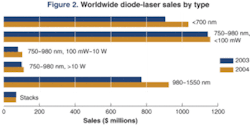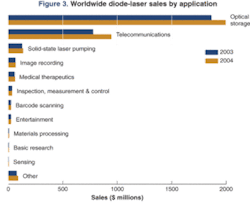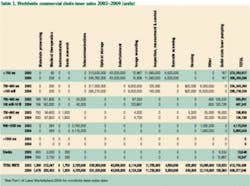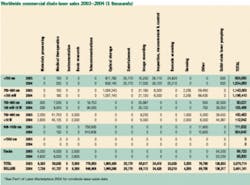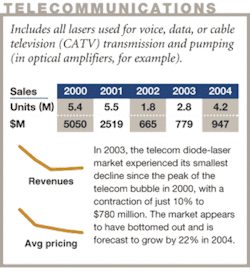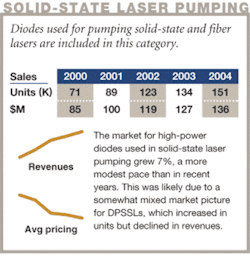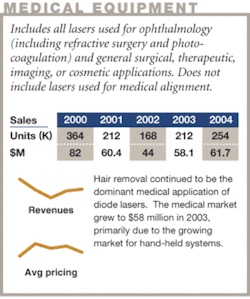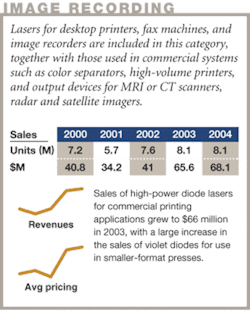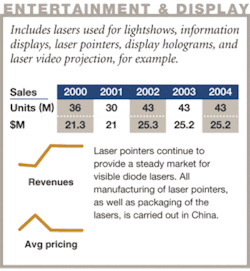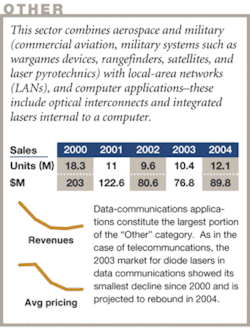Review and forecast of the laser markets: Part II: Diode lasers
The Laser Focus World 2004 annual review and forecast of the laser marketplace is conducted in conjunction with Strategies Unlimited, an optoelectronics market-research firm based in Mountain View, CA. Part II covers the diode-laser marketplace. Part I, which reported on nondiode-laser markets, appeared last month.
After two years of successive declines, the diode-laser market rebounded nicely in 2003, growing by 18% to reach $3.07 billion, slightly higher than last year's forecast of $2.81 billion. Although far from the peak of $5.71 billion reached in 2000, the market is at least growing again, and appears likely to continue to do so. As in 2002, the fastest growing sector was optical storage for consumer applications, particularly DVD players and DVD recorders. This growth more than offset the continuing decline in the telecom laser market. Moreover, telecom laser revenue declined by a smaller amount in 2003 than in any year since the peak of the telecom bubble in 2000.
Because of the large contribution to the market of diode lasers for optical storage (61% in 2003) and because the vast majority of these lasers are manufactured in Japan (as well as lasers for other applications such as barcode scanners and desktop printers), the changing value of the Japanese yen against the U.S. dollar can have an impact on the apparent market growth. The value of the yen increased from 125 per dollar in 2002 to 116 in 2003. This strengthening of the yen contributed about 5 percentage points to the apparent market growth of 18% in 2003, as expressed in U.S. dollars.
The recent history of the diode-laser market is shown in Fig. 1. Diode-lasers sales data for 2003 and 2004 are charted in detail by type and application in Fig. 2 and Fig. 3. Diode-laser sales data by unit shipment and dollar revenues are shown in Tables 1 and 2, respectively. The history shown in Fig. 1 includes a forecast for 2004 and clearly shows the impact of the telecom bubble in 1999 and 2000, which significantly distorted the historic growth pattern of the market. In 2002–2004 the market is returning to something like "normal" growth. The major difference from earlier years (1996–2001) is that optical storage has become the largest application category, while telecom was the dominant application earlier. The average market growth rate from 1996–2004 was approximately 10% per year.
For 2004, continued growth is projected across all applications, including telecom. This will be the first year that the telecom diode-laser market has grown since 2000, although the growth rate, and the absolute market value, are much lower than during the high-growth years of 1998–2000. Overall, the diode-laser market is projected to grow 11% (close to the historical average) to $3.40 billion in 2004.
Optical storage
As in 2002, diode lasers used in various types of optical storage—CD players, CD-ROM drives, CD-RW drives, DVD players, DVD recorders, and so forth—were the major source of growth for the diode-laser market in 2003. Overall, the market for optical-storage lasers grew from $1.40 billion and 477 million units in 2002 to $1.87 billion and 531 million units in 2003, corresponding to revenue growth of 34% and unit growth of 11%. Revenue growth exceeded unit growth because of the higher prices and higher growth rates of the visible (650-nm) lasers used in DVD-type drives compared to the 780-nm lasers used in CD-type drives. The visible-laser market grew from $513 million in 2002 to $911 million in 2003, or 78%.
The ever-increasing popularity of DVD players and various versions of recordable DVD drives (DVD-RW, DVD+RW, DVD-RAM, and so on) is the main driver for the optical-storage diode-laser market. The price of DVD players has fallen to the $100 range and even lower in some cases, and DVD has become the dominant medium in the home video market, in both rental and retail sales. The penetration of DVD players in U.S. households exceeds 50%, and penetration is growing in other parts of the world as well.
A major factor in the growth of the optical-storage market in 2003 was the rapid growth in recordable DVD drives. Although prices for these drives have been high, they began to decline substantially in 2003. Toward the end of the year, prices of stand-alone drives for consumer video recording fell below $400, and prices are expected to decrease even further in 2004. As a result, penetration into the home-video-recording market has been brisk in 2003. However, the main factor in the market growth has been the inclusion of rewritable DVD drives in personal computers. These drives have begun to replace CD-RW drives as standard equipment on high-end PCs, and are priced at well under $200.
Although the multiplicity of recordable DVD formats has been a factor holding back the market, the compatibility problem among the various DVD recordable drive types has begun to be addressed by the development of multiformat drives. In the second half of 2002, recordable DVD manufacturers released a succession of multiformat drives, mostly of two types. The first type was the DVD-Multi–compliant drive, which supports the DVD±R, DVD-RAM, and DVD±RW standards specified by the DVD Forum; the other is the DVD+RW drive, supporting the DVD-RW and DVD+RW record-and-play formats. Hitachi-LG Data Storage Co. was the first to make a move, shipping a DVD-Multi drive for use in PCs at the end of May 2002. In the second half of 2002, DVD-Multi drives were being shipped by firms including Matsushita Electric, Samsung Electronics, and Toshiba, while NEC, Sanyo Electric, Sony and others shipped DVD±RW drives. The introduction of these drives paved the way for the market ramp-up in 2003.
The potentially big news in optical storage for 2003 was the widely anticipated commercial introduction of the next generation of high-density DVD (HD-DVD) recorders using 405-nm diode lasers. At Sony Dream World 2002, held in September, Sony unveiled a prototype of its Blu-ray Disc recorder. At the CEATEC Japan show (the annual Japanese electronics show) in Tokyo in October 2002, several members of the Blu-ray Disc Consortium (Hitachi, Matsushita, Pioneer, Philips, Samsung, Sharp, and Sony) showed prototypes of their high-density DVD recorders. Toshiba also showed its version based on the rival 0.6-mm format developed by Toshiba and NEC.
In April 2003, Sony announced the release of the first commercial version of its Blu-ray Disc recorder, termed the BDZ-S77. Sony's suggested retail price was ×450,000 ($3,800). The BDZ-S77 incorporates a tuner for digital broadcasting and can record high-definition television (HDTV) formatted video for about two hours. The BDZ-S77 can not only record/replay rewritable Blu-ray Disc media but it can also replay DVD-video and DVD-RW disks, DVD-R disks, music CDs, and CD-R/RW disks.
Sony also announced the release of 23-Gbyte rewritable media. Its price was ×3,500 ($30). In addition to 23-Gbyte media, there will be single-sided layer media for 25 Gbytes and 27 Gbytes, and single-sided, double-layered media, but Sony has only verified the recording/replaying of a 23-Gbyte single-sided, single-layered media.
For the BDZ-S77, Sony developed an optical pickup based on Nichia's 30-mW, 405-nm laser diode. The pickup uses a circular prism to create a nearly circular beam and has an objective lens with a NA of 0.85, as well as a uniaxial actuator to correct the spherical aberration caused by the uneven thickness of the disk protective layer. A second pickup, which uses an integrated 650-nm/780-nm laser source, is used to read CD and DVD media.
In early April 2003, Sony also announced the introduction of a Blu-ray Disc optical-storage drive for the professional data-storage market. The drive is targeted for professional data-intensive applications such as document and medical imaging, e-mail archiving, enterprise content management, multimedia projects, graphics design, and audio/video editing.
While there was much hype and excitement around the introduction of these high-capacity optical-disk recorders, sales in 2003 were slow, probably on the order of several thousand units. It will take several years (much as occurred with the first DVD recorders introduced in 1998) for the market to develop and for prices to come down significantly.
In 2003, the largest share of the $1.87 billion market for diode lasers used in optical-storage drives (57%) was still for 780-nm lasers used in CD players,
CD-ROM drives, CD-RW drives, and MiniDisc players. However, visible (650-nm) lasers used in DVD-type drives are the fastest growing, and should overtake 780-nm lasers in the next few years. Shorter-wavelength (405-nm) lasers used in HD-DVD drives will not likely make a significant contribution until 2005 and beyond.
Telecommunications
Following two years of steep declines, the market for lasers for fiberoptic telecommunications appears to have hit bottom in 2003, with laser suppliers reporting improvement in sales in the latter half of the year. Overall, sales amounted to about $780 million for both transmitter and pump lasers. With corrections to last year's market estimate for 2002, this reflects a contraction of about 10% in the market.
Sales in 2004 are expected to reach about $950 million, an increase of more than 20%. Growth could very likely be much greater, coming off the new starting point for the market, but no one can confidently defend higher growth rates at this time due to the continuing poor visibility in the industry.
Unit sales for transmitter lasers are growing to match increasing demand for telecom traffic, but the prices continue to fall as steeply as ever. There are several reasons for this, including a sizable share of sales to Asia at heavily discounted prices. Prices should stabilize in 2004, but a remarkably large number of suppliers still remain. Well over 40 companies offer products in this segment, and so far there have been only a few companies acquired or closed. Laser-manufacturing operations of some the largest players have changed hands (TriQuint's acquistion of Agere's optoelectronics operation, for example; Bookham's acquisition of Nortel's component business, and the sale of Alcatel Optronics to Avanex), but the basic production and marketing activities have continued under the new ownership.
Sales of 980- and 1480-nm pumps for optical amplifiers continued to be weak but have turned the corner. Unit sales were up but prices continued to fall in 2003. There is some consolidation occurring among suppliers. With high-technological barriers to entering the pump business, prices should firm up in 2004. Revenues will jump, but they have a long way to go before the business is healthy again.
Pumps for solid-state lasers
High-power diode lasers used as pumps for solid-state lasers (including 750 to 980-nm diodes in the 100 mW to 10 W, >10 W, and Stacks categories, as well as a small quantity of high-power visible lasers) continued their historical growth trajectory in 2003, although at a somewhat lower rate than in recent years. The pump-diode market grew from $119 million in 2002 to $127 million in 2003, or 7%, while units grew by 9% to 133,800. Although diode growth usually correlates well with growth in the diode-pumped solid-state laser (DPSSL) market, the results of the latter market were somewhat confusing—units were up more than 30%, while revenues were down 6% in 2003 (see Laser Focus World, January 2004, p. 75 and January 2003, p. 75). Sales of DPSSLs for materials processing experienced a particularly large decline, while instrumentation increased dramatically.
One of the most promising developments in DPSSLs has been the development of high-power, kilowatt-class diode-pumped lasers. Many advantages have been touted for these devices, including higher beam quality, higher reliability, and lower energy consumption compared to lamp-pumped lasers. However, early trials of these lasers in industrial applications in Europe have been somewhat disappointing, apparently due to some diode failures. Therefore, the wider adoption of kilowatt-class DPSSLs may be delayed until these problems are solved.
Overall sales of diode lasers for solid-state laser pumping are forecast to increase by 14% to $135 million in 2004. However, the sales of stacks for high-power systems are expected to decrease somewhat, likely due to the situation discussed above. One of the strong drivers in the lower-power end of the market will be fiber lasers, the use of which is growing rapidly in a variety of applications.
Medical
The medical market for high-power diode lasers showed a strong uptick in 2003, increasing by 32% to $58 million. This growth was driven largely by the hand-held hair-removal market. While other medical applications, including ophthalmic, surgical, and dental held steady, the market for discrete diodes and bars used in hand-held hair- removal equipment grew by 44%. This was offset somewhat by the 40% decline in the sales of diode stacks for large stationary hair-removal equipment offered by companies such as Lumenis. Sales of diode stacks for this application fell by an estimated 40% to $9 million.
Other than hair removal, the medical diode-laser market continues to grow at a modest rate. Ophthalmic use of diodes in the 100-mW to 10-W range is primarily for retinal photocoagulation, which is roughly a $1 million market. Most other applications are for diode bars (>10 W) and include general medical/surgical applications as well as dental. Although still small, dental seems to be the fastest growing at the moment. Overall medical applications other than hair removal are in the $11 million to $12 million range, with the expectation of about 15% growth in 2004.
Printing/graphic arts (image recording)
The commercial printing market for diode lasers showed significant growth in 2003, accompanied by a shift in laser technology. The market for high-power 830-nm discrete diodes and bars increased by 10% to $29 million, but the market for violet (405-nm, 30-mW) diodes grew dramatically (although it was likely underestimated in 2002). This technology shift occurring in this market was discussed in part I of this article on nondiode lasers (see Laser Focus World, January 2004, p. 87) based on input from Peter Dyson of the Seybold Report, and is summarized below.
The offset printing industry uses two main laser technologies: 830-nm thermal-diode arrays and 405-nm violet diodes. Until this year, thermal dominated on large presses (eight-page and up) because photopolymer plate coatings capable of million-impression runs were available only for thermal wavelengths. In the small-press market, violet dominated because of lower capital costs. But in 2003, Fuji released a violet-sensitive long-run photopolymer plate, and the 30-mW diodes needed to expose it became widely available. Brazilian vendor IBF is expected to bring out its violet-polymer plate this winter. The recent adoption of 40 mW will allow faster exposure of these plates. As a result, violet diodes and plates should move into the large-format market, but thermal is not likely to move to the smaller-format market.
There is one exception to this trend. Presstek (Hudson, NH), a minor player in this market, offers imagers based on 915-nm diodes made by its Lasertel subsidiary. It also has several plate technologies—including ablative and phase-change—that allow platemaking without any post-exposure chemistry—a substantial savings in consumables and waste disposal for printers. AB Dick, the biggest player in the small-press field, began selling Presstek's two-page imagers and plates in the fall of 2003. Presstek's competitors will be watching to see how well AB Dick does. If it thrives, other plate suppliers (like Agfa and Kodak) will be likely to introduce their own phase-change coatings, which are mostly sensitized to 830 nm, and try to sell them into the small-press market also.
The overall market for commercial printing/graphic arts is projected to grow 7% to $47 million in 2004, with most of the growth expected to be in violet diodes.
Entertainment and display/inspection and measurement/barcode scanning
These markets for low-power visible diode lasers do not change much from year to year, with the exception of barcode scanning, which continues to experience steady growth. While visible lasers for barcode scanning are still largely made in Japan, almost all other visible laser applications are served by low-cost lasers that are made in Taiwan and either packaged there or in China. The latter is especially true of laser pointers, which have plummeted in price in the past few years.
The "Inspection, measurement and control" category includes a wide variety of visible laser applications, like survey instruments, industrial pattern generation, laser gunsights, laser levelers, and many others. For specialty applications requiring higher visibility and/or longer range, 635-nm rather than the standard 670-nm lasers are used. These are more sophisticated index guided, rather than gain guided, devices, that are primarily made in Japan. These lasers accounted for around 18% of this $34 million market in 2003.
Others
The "Others" category includes Military/Aerospace and Local-area networks. The latter designation is taken to include storage-area networks (SANs), which operate using the Fibre Channel communications standard, as well as true local-area networks (LANs) that operate with the Ethernet protocol. The diode-laser-based transeivers used in these applications include 850-nm VCSELS (included in the 750–980 nm, <100 mW category) and 1310-nm edge-emitting lasers. Ethernet networks include a variety of data rates, from 10 Mbit/s to 10 Gbit/s, but lasers are only used at 1 Gbit/s and above. Over the past two years, Fibre Channel-based SANs have shifted almost entirely from 1 Gbit/s to 2 Gbit/s.
As was the case with the telecom market, lasers used in LAN and SAN transceivers experienced a downturn in the three years following the 2000 market peak, although the decline was not so severe as for telecom lasers. Also, as in the case of telecom lasers, the market appears to have bottomed out in 2003, and growth is forecast for 2004. In fact, there was a modest increase in unit sales of VCSELs and 1310-nm lasers in 2003, but this was offset by declining prices. The total LAN/SAN market for diode lasers in 2003 was $72 million in 2003. As the economy continues its recovery into 2004, and corporate investment in information technology picks up speed, the market is forecast to grow to $82 million.
The next big ramp-up in data rates for both LANs and SANs is 10 Gbit/s. In Ethernet networks, the move to 10 Gbit/s has been very slow, due to the high cost and a lack of customer demand, and 10-Gbit/s lasers were not a significant contributor to the market in 2003. In SANs, there has been much discussion in the past year of 4 Gbit/s as an alternative to 10 Gbit/s, primarily due to the lower cost of implementing 4 Gbit/s and doubts as to whether 10 Gbit/s is really needed in the next few years. This issue will likely be resolved sometime during 2004.
Military markets include primarily high-peak-power diode lasers used in ordnance initiation, war games, and range finding. Wavelengths include 915 and 1550 nm. The latter is used primarily for range finding because this wavelength is in the eye-safe region of the spectrum. The Military/Aerospace market totaled $6.5 million in 2003, and it is forecast to increase to $7.75 million in 2004.
ROBERT V. STEELE is director of optoelectronics at Strategies Unlimited, 201 San Antonio Circle, Suite 205, Mountain View, CA 94040.
CORRECTION
Due to a reporting error, "The annual review and forecast, Part I" incorrectly stated revenues for Thales (Paris, France). Thales revenues In the first half of 2003 were actually ¤4.56 billion (US$5.34 billion). Laser Focus World regrets the error (see January 2004, p. 77).
Diode-laser products and configurations
The diode-laser revenue figures shown in Table 2 are based on the unit sales figures in Table 1 and average selling prices (ASPs) for each type of diode laser. The ASPs for diode lasers vary widely and are a function of wavelength, power output, and package type. The revenue figures are for packaged devices as they are sold by diode-laser suppliers to the merchant market or transferred internally to other company divisions to be used in system-level products. Diode-laser packaging is subject to a wide range of configurations according to the device type and application requirements, and includes variations such as thermal control and fiber coupling. Short-wavelength (<1000 nm) diode lasers at power levels less than 200 mW are almost always single-lateral-mode, single-stripe devices that are sold commercially in hermetically sealed TO-type packages. The lasers are typically mounted on a heat sink, and the complete package includes a back facet photodetector for monitoring the laser output level. The selling prices of such devices range from less than $1 for a high-volume CD-type laser to around $2 for a low-power visible (650-nm) laser to around $7 for a 50-mW, 650-nm laser used in rewritable DVD applications. Some low-volume specialty devices can be priced much higher.
An increasingly important packaging concept in the low-power diode-laser market, originating in audio CD and CD-ROM applications that use 780-nm laser diodes, but now used widely in DVD applications that use 650-nm laser diodes, is to carry out hybrid integration of the diode-laser chip, detector chips, and optical elements in a single package. These integrated optical pickups are lower in cost than pickups fabricated from discrete components, and result in easier assembly for the optical-disk-drive manufacturer. This concept was introduced by Sony in 1991 for its very thin (15-mm) Walkman CD player. Such pickups are now manufactured in volume by Sony, Sharp, and Matsushita, with prices around $1.80 to $4.20, compared to less than $1 to $2 for a discrete packaged diode laser. The value of such pickups is included in the diode-laser market units and revenues in Tables 1 and 2. The concept of integration has also extended to combining 780- and 650-nm lasers in a single package. These are used in DVD players and DVD-ROM drives so that CD-type media can be read in the same drives. This type of integrated package is included in the statistics on lasers in the <700 nm category in Tables 1 and 2.
For high-power diode lasers (>1 W) there is a wide range of power levels and configurations. Up to 5 W CW, a wide (up to 500 µm) single-stripe, multimode device is the norm. These devices are usually supplied in TO-type packages that can include Peltier coolers for temperature control. Beyond about 5 W, the only commonly used approach is a multistripe, multimode array. The standard product at these power levels is a 1-cm-wide diode-laser bar, which consists of a single multistripe array or a grouping of several arrays to build up higher power levels. Pricing for high-power diode lasers ranges from under $200 for a 1-W discrete device in quantity up to $2,000 for a 50-W bar. Single-laser bars are now available at power outputs up to 60 W CW, although 50 W is still the most common configuration. Increasingly, these high-power devices are sold with fiber coupling in order to provide a more usable output beam for the end user. Higher-power arrays are typically available on a heat-sink submount that can be attached to a water-cooled heat-removal system. For applications requiring high peak power, these arrays can be operated in the pulsed (quasi-CW, or QCW) mode at peak powers up to 100 W.
For power levels above 60 W CW, high-power diode-laser bars can be stacked in the vertical dimension (these products are included the Stacks category in Tables 1 and 2). Because of the difficulty in removing heat from such a configuration, these stacks are typically operated in the QCW mode. Peak output power approaching 5 kW can be achieved from such a stack. The packages for these devices typically include water cooling, although conduction cooling may be used in lower-duty-cycle devices. With the development of more-efficient heat-removal techniques (such as microchannel coolers), CW stacks have become available.
The packages for long-wavelength (>1000-nm) diode lasers used in telecommunications applications include special adaptations for coupling the laser output to single-mode (approximately 9-µm core diameter) optical fiber with tolerances on the order of ±1 µm. These are in the form of fiber pigtails or single-mode connectors. Telecommunication laser packages can also include other elements such as thermoelectric coolers for temperature control and optical isolators to reduce the amount of light reflected from the fiber back into the laser. All laser packages include back facet monitor photodiodes. Because of the expense of fiber coupling and other package features, telecommunications diode lasers typically have high ASPs. Prices range from less than $50 for the lowest performance 1310-nm Fabry-Perot devices in a connectorized coaxial package to $500 to $1000 for a high-performance distributed-feedback (DFB) laser in a cooled butterfly package with fiber pigtail. Diode lasers used in short-distance data communications applications with multimode fiber have much lower prices. For example, 850-nm VCSELs packaged in several different configurations are priced at well under $10.
Where the numbers come from
The Laser Focus World annual review and forecast of the laser marketplace is based on a worldwide survey of laser producers and covers 27 types of lasers and 20 applications. Information about diode-laser markets is provided by Strategies Unlimited (Mountain View, CA). The review is the only major survey of its kind in this industry whose results are made public.
For many, both inside and outside the industry, from private-sector investors to foreign and U.S. government bodies, this report is the only objective summary of major trends in our industry that is readily available. Part I takes a look at the overall market trends with more detail on nondiode lasers. Part II will be published in February and will cover the diode-laser marketplace.
Readers interested in the detailed results of both surveys will find them in the January 1 and February 1 editions of the Optoelectronics Report newsletter, published by Laser Focus World. A more extensive review of the data, with supporting commentary from market analysts, was available to attendees at the Laser and Optoelectronics Marketplace Seminar, held in conjunction with Photonics West (San Jose, CA) on Jan. 26. Proceedings of the seminar are available for purchase. Call 603-891-9267 for more information.
Collecting the data
We conducted our research and analysis for the Review and Forecast during October and November 2003. We asked manufacturers to provide an estimate of total worldwide market size (dollars and units) for 2003, based on year-to-date actual data, and a forecast for 2004. In addition to the information provided by the manufacturers, we also used data from other more narrowly focused market surveys, and incorporated commentary provided by industry analysts to add insight into some of the markets.
Comparison with last year's numbers
Readers who compare last year's 2003 estimates with this year's restated 2003 numbers will note differences and occasional discontinuities in the numbers reported as compared to last year. In general, no attempt has been made to explain these differences in detail. We request "bottom-up" market estimates, and the respondents to our survey do vary from year to year—both in terms of the companies involved and the individuals—so variations in the results are inevitable. In addition, changes in market visibility occur as market shares change. Differences in the overall numbers for 2003 last year and for 2003 this year may also reflect whatever degree of optimism or pessimism was inherent in last year's forecast (see Laser Focus World, February 2003, p. 63). –SGA
